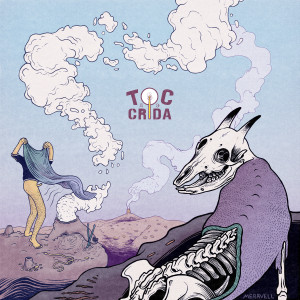 Toc de Crida sounds kind of like your favorite Celtic folk rock band just returned from a long holiday in Mallorca. In fact that’s where they’re from, the Spanish island in the warm, sunny Mediterranean. On their debut self-titled album they fuse the traditional music of Mallorca with modern and folk sounds and instruments of Northern Europe, North Africa, Brazil, around the Mediterranean, and the Iberian peninsula’s Valencia, Catalonia, and Basque country.
Toc de Crida sounds kind of like your favorite Celtic folk rock band just returned from a long holiday in Mallorca. In fact that’s where they’re from, the Spanish island in the warm, sunny Mediterranean. On their debut self-titled album they fuse the traditional music of Mallorca with modern and folk sounds and instruments of Northern Europe, North Africa, Brazil, around the Mediterranean, and the Iberian peninsula’s Valencia, Catalonia, and Basque country.
Which is not to say it’s derivative or Celtic light. It just has similar instrumentation to what you’ll find in a lot of European folk music. In Mallorca the makers of traditional music were known as the colla de xeremiers, named I guess for the Mallorcan bagpipes known as the xeremies. Other instruments include a small drum known as the tumbarí and an end-blown wooden flute called flabiol, both of which were played by the same person, flute with one hand and hitting the drum with a stick or mallet held in the other. In Toc de Crida that role falls to founder Pau Mas Salom, whose idea it was to play this music with the traditional instruments plus some modern ones. On this all-instrumental recording he’s joined by Sara Mingolla Ramis on accordion and percussion; Benjamí Salom Miró on violin and guitarró; Pablo Alegría Calmaestra on electric and acoustic guitars, Joan Vázquez Amer on electric bass, and Miquel Amengual Perales, drums and percussion. They’re joined by several guests including Josep Rotger Martínez, one of Pau’s mentors, on xeremies.
The eight tracks on Toc de Crida have varying degrees of modern instruments and arrangements, but they’re all at base very connected to Mallorcan roots. “Pep Pinxo” has a bit of a Steeleye Span feel to it, starting off as a peppy march on flabiol and tumbarí before the electric bass and guitar enter for a tango-like interlude with faint psych overtones and some improvised playing on the oboe-like instrument called the gralla – then the march returns with the electric guitar giving it some North African color. Likewise the second track “Es Destö” begins as a languid pastoral flute tune before giving way to a folk-rock rave up with modern rock instruments and rhythms, although the flute is a constant. “Pebre coent, pebre calent,” which may reference hot chili peppers, has some fancy duet work between accordion and flute, with some shimmery electric guitar and a driving rock beat. The violin doubles on the melody with a very high flute on the sunny “Jota de Son Pujol,” which has a stirring lute solo by guest Toni Pastor Garcia.
“Valse d’aigua” could pass for a Parisian bal musette waltz if not for the flabiol and drum kit, as Salom Miró and Mingolla Ramis play some very nice violin and accordion, respectively. It was a good choice for a promotional video, as you can see here:
Altogether Toc de Crida is a very enjoyable introduction to Mallorcan folk rock. I’d like to hear more of the xeremies, which when they do appear are mostly very low in the mix. But otherwise, a lovely excursion into the varied world of Mediterranean traditional music.
(Microscopi, 2023)
